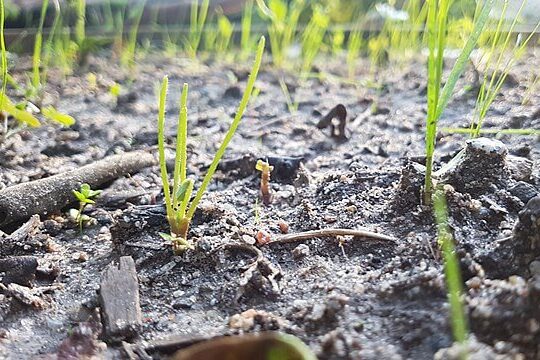
A groundbreaking study has unveiled a startling revelation about the Earth’s biodiversity: more than half of all species inhabit the soil, marking it as the single most species-rich habitat on our planet.
This astonishing discovery effectively doubles previous estimates made in 2006, when scientists believed that only 25% of life existed in soil-based environments.
The findings, recently published in the journal Proceedings of the National Academy of Sciences, paint a vivid picture of the intricate web of life beneath our feet. According to the study, the soil provides shelter to a staggering 90% of fungi, 85% of plants, and over 50% of bacteria. Surprisingly, mammals, comprising just 3% of soil inhabitants, are the group least associated with this habitat.
“Here, we show that soil is likely home to 59% of life including everything from microbes to mammals, making it the singular most biodiverse habitat on Earth,” researchers write in the paper, which is a review of existing literature. The actual figure could be even higher as soils are so understudied, they say.
Dr. Mark Anthony, an ecologist at the Swiss Federal Research Institute for Forest, Snow, and Landscape Research and the lead researcher of the study, notes that before this research, the scientific community remained uncertain about which habitat boasted the most species diversity.
“In my research circle, many suspected it should be soil but there was no evidence.”
He added: “Organisms in soil play an outweighed impact on the balance of our planet. Their biodiversity matters because soil life affects climate change feedbacks, global food security, and even human health.”
Soil, often overlooked in discussions about nature preservation, constitutes the Earth’s uppermost layer, composed of a complex blend of water, gases, minerals, and organic matter. It is the cradle of 95% of the world’s food production, yet its significance has historically been overshadowed by its mysterious nature. Astonishingly, a single teaspoon of healthy soil may harbor up to a billion bacteria and stretch over a kilometer in terms of fungi.
To arrive at this revelation, researchers began with the rough estimate of approximately 100 billion species in total. Employing theoretical calculations and data analysis, they discerned what fraction of these species inhabited the soil. Their criteria for defining a species as soil-based included living within, on, or completing a portion of its lifecycle in the soil. Other habitats under scrutiny included marine, freshwater, the ocean floor, the atmosphere, the built environment, and organisms that serve as hosts, including humans.
It is essential to note that the estimation carries a margin of error of 15%, making the average prediction subject to variations, potentially ranging from as low as 44% to as high as 74%. For some categories, such as bacteria, the range was particularly broad, spanning from 22% to 89% residing in soil environments.
Anthony said: “What actually surprised me the most was the sheer challenge of this undertaking, and how much variation there is to our estimates for many large groups, particularly bacteria and viruses, the two most diverse forms of life on Earth.
“Keeping that in mind, our estimate is really a first attempt to organise existing global richness albeit with quite a large error to many of the estimates. While true diversity lies somewhere within this range, our effort is the first realistic estimate of global diversity in soil, and we need it to advocate for soil life in the face of the biodiversity and climate crises.”
This revelation bears significant ecological implications. With one-third of the planet’s land already severely degraded and the annual loss of 24 billion tonnes of fertile soil due to intensive farming, as reported by a UN-backed study, the Global Land Outlook, urgent action is imperative. Soil faces threats from pollution, deforestation, and the impacts of global warming.
Researchers advocate for the adoption of less intensive agricultural practices, stricter regulation of non-native invasive species, and heightened efforts in habitat conservation to boost soil biodiversity. Additionally, innovative techniques like soil transplantation may offer a means to restore microscopic lifeforms within the soil, further enhancing its ecological resilience. Recognising the astonishing diversity concealed beneath our feet underscores the critical importance of safeguarding and restoring the health of our soils.
Dr Roy Neilson, an ecologist from the James Hutton Institute in Dundee, who was not involved in the research, said: “It is extraordinarily difficult to enumerate soil biodiversity … The approach taken in this study arguably generates the current best estimate of global soil biodiversity.
“However, as the authors note, generating these estimates has been challenging and they are transparent as to the level of robustness of their data, which in turn highlights areas for future scientific investigation,” said Neilson, who is an author on the British Ecological Society’s upcoming report on regenerative agriculture.
——————————————————————————
At Natural World Fund, we are passionate about stopping the decline in our wildlife.
The decline in our wildlife is shocking and frightening. Without much more support, many of the animals we know and love will continue in their decline towards extinction.
When you help to restore a patch of degraded land through rewilding to forests, meadows, or wetlands, you have a massive impact on the biodiversity at a local level. You give animals a home and food that they otherwise would not have had, and it has a positive snowball effect on the food chain.
We are convinced that this is much better for the UK than growing lots of fast-growing coniferous trees, solely to remove carbon, that don’t actually help our animals to thrive.
This is why we stand for restoring nature in the UK through responsible rewilding. For us, it is the right thing to do. Let’s do what’s right for nature!
Donate today at https://naturalworldfund.com/ and join in the solution!

